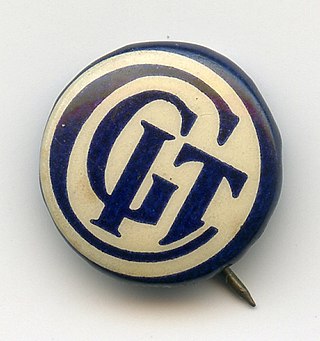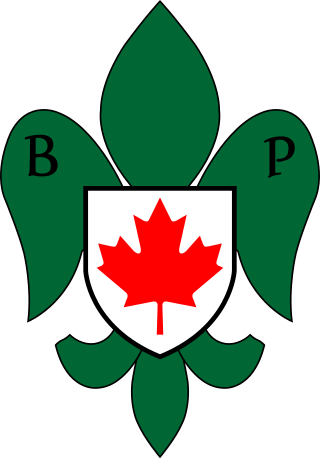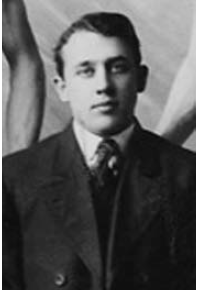TUXIS was a boys' program similar to the Scouting movement promoted by Canadian Protestant churches. There are a number of variations of what the acronym TUXIS is said to stand for. Most commonly, it is said[ by whom? ] to stand for "U ('you') and I in Training and Service with Christ ('X'; the first letter of Christ in Greek) in the centre". Another similar meaning was Training Under Christ In Service.
During the late 19th and early 20th centuries, a "boys' work" movement developed in response to the need for activities for young men who worked by day but were idle by night. The YMCA was one of a number of organizations that developed various programs in response. These programs usually incorporated the YMCA philosophy based upon the "fourfold" development of the physical, mental, spiritual and social well-being of the person, based upon Luke 2:52: "And Jesus grew in wisdom and stature, and in favor with God and men." [1] These programs met with varied success.[ citation needed ]
One of the strongest proponents of boys' work programmes within the YMCA was Taylor Statten, a Second Boer War veteran. In 1912, Statten became the Boys' Work Secretary on the national YMCA executive. Borrowing from both Canadian and American YMCA programs, and aspects of the Boy Scouts, Statten established the Canadian Standards Efficiency Training (CSET) program, a system of graded tests where boys passed from one level to the next. These standards were borrowed from the "fourfold" philosophy.[ citation needed ]
Under the CSET program, TUXIS was established for boys aged 15 to 17. A similar program called Trail Rangers was developed for boys aged 12 to 14. A parallel program was established for girls, called the Canadian Girls in Training (CGIT). The TUXIS program included midweek activities of Sunday school classes, outdoor activities, and community service. Camping was a significant activity and component of the TUXIS program.[ citation needed ]
Soon after its creation, the YMCA joined with a number of Protestant churches to establish the National Boys' Work Board. However, the YMCA decided to focus on its other programs, and the National Boys' Work Board came under the control of the Religious Education Council of Canada (REC). The United Church of Canada came to dominate the Boys' Work Board and the TUXIS program.[ citation needed ] J. Howard Crocker was a liaison between TUXIS and the YMCA in Canada via the Boys' Work Board. [2]
The TUXIS movement enjoyed success in the 1920s and 1930s. In the early 1920s, the TUXIS movement brought about the establishment of a number of Canadian Youth Parliaments. The onset of World War II stifled the organization and development of TUXIS. By the end of the war, the TUXIS movement had diminished, and the National Boys' Work Board was in a weak state of affairs. The program went into decline in the post-war years. By the 1970s, the TUXIS movement was essentially finished. The CGIT program continues to operate in nearly all provinces. The word TUXIS survives as a vestigial part of the name of the TUXIS Parliament of Alberta.[ citation needed ]

Scouting, also known as the Scout Movement, is a worldwide youth social movement employing the Scout method, a program of informal education with an emphasis on practical outdoor activities, including camping, woodcraft, aquatics, hiking, backpacking, and sports. Another widely recognized movement characteristic is the Scout uniform, by intent hiding all differences of social standing in a country and encouraging equality, with neckerchief and campaign hat or comparable headwear. Distinctive uniform insignia include the fleur-de-lis and the trefoil, as well as merit badges and other patches.

YMCA, sometimes regionally called the Y, is a worldwide youth organization based in Geneva, Switzerland, with more than 64 million beneficiaries in 120 countries. It has nearly 90,000 staff, some 920,000 volunteers and 12,000 branches worldwide. It was founded in London on 6 June 1844 by George Williams as the Young Men's Christian Association. The organization aims to put Christian values into practice by developing a healthy body, mind, and spirit.

A Scout is a child, usually 10–18 years of age, participating in the worldwide Scouting movement. Because of the large age and development span, many Scouting associations have split this age group into a junior and a senior section. Scouts are organized into troops averaging 20–30 Scouts under the guidance of one or more Scout Leaders or Scoutmasters. Troops subdivide into patrols of about 6–8 Scouts and engage in outdoor and special interest activities. Troops may affiliate with local, national, and international organizations. Some national Scouting associations have special interest programs such as Air Scouts, Sea Scouts, outdoor high adventure, Scouting bands, and rider Scouts. In the USA there was around 6 million scouts in 2011.

Scouts Canada is a Canadian Scouting association providing programs for young people, between the ages of 5 and 26, with the stated aim "To help develop well-rounded youth, better prepared for success in the world". Scouts Canada, in affiliation with the French-language Association des Scouts du Canada, is a member of the World Organization of the Scout Movement. In 2021–22, youth membership stood at 33,899, a 48% decline from 64,693 in 2014–15. Over the same period, volunteer numbers also declined 43%, from 20,717 in 2015 to 11,765 in 2022. Scouts Canada has declined significantly in size since its peak: youth membership is down 82% from 288,084 in 1965 and volunteer numbers are down 50% from 33,524 in 1965.
The history of youth work goes back to the birth of the Industrial Revolution in the 18th century, which was the first time that young men left their own homes and cottage industries to migrate to the big towns. The result of this migration was an emergent youth culture in urban areas, which was responded to by the efforts of local people.

Youth Parliament of Manitoba Inc. (YPM) is a non-partisan, non-denominational, and incorporated registered charity based in Manitoba, Canada.

The British Columbia Youth Parliament (BCYP) is a youth service organization that operates in the guise of a "parliament" in the Canadian province of British Columbia. The BCYP fulfills its motto of "Youth Serving Youth" by means of "legislation" enacting community service projects and other youth-oriented activities. The BCYP is the successor to the Older Boys' Parliament of British Columbia, which first met in 1924.
Traditional Scouting is "old-fashioned" or "back to basics" Scouting in some form, often with an emphasis on woodcraft and scoutcraft activities. As a pluralist movement, there is no one set definition for the term, but most traditionalists share a common set of values and procedures. Traditionalists aim to return the Scout Movement to something approximating its original style and activities; rejecting the trend of modernizing the program in an attempt to widen its appeal and/or use the name "Scouts" for new programs for ever-younger children.
The Alberta Youth Parliament (AYP) is one of a number of provincial model youth parliaments that has its origins in the "boys work" movement of the nineteenth and early twentieth centuries. It is the oldest youth parliament in Alberta, and the longest continuously operating youth parliament in Canada. Its flagship session occurs every December in the Alberta Legislature, and it hosts a variety of smaller events throughout each year. It is open to all youths in Alberta who are between the ages of 15-21.

The Ontario Youth Parliament (OYP), formerly the Ontario Older Boys' Parliament, is one of a number of provincial youth model parliaments across Canada. Each year, the organization holds a four-day debate conference on Family Day weekend for youth ages 14 to 21 from Ontario, Canada. The organization has roots within the United Church of Canada dating back to 1907. The first session of the Older Boys' Parliament met in the Ontario Legislative Building at Queen's Park in Toronto in January 1925. As a result, the OYP, as successor to the Older Boys' Parliament, is one of the oldest youth parliaments in Canada. Gordon Lapp of Brighton served as the first Premier.
The Newfoundland and Labrador Youth Parliament (NLYP) is one of a number of provincial youth model parliaments across Canada.

The Boy Scouts of America (BSA) was inspired by and modeled on The Boy Scouts Association, established by Robert Baden-Powell in Britain in 1908. In the early 1900s, several youth organizations were active, and many became part of the BSA.

Canadian Girls in Training, or CGIT, is a church-based program for girls and young women aged 11–17 throughout Canada. Girls who join the CGIT vow to "Cherish Health, Seek Truth, Know God, Serve Others and thus, with [Jesus'] help, become the girl God would have me be".
Non-aligned Scouting organizations is a term used by the World Organization of the Scout Movement (WOSM), World Association of Girl Guides and Girl Scouts (WAGGGS) and their member national organizations to refer to Scouting organizations that are not affiliated with them. See List of non-aligned Scouting organizations.

There are various controversies and conflicts that involve the Scouting movement. Scouting has sometimes become entangled in social controversies such as in nationalist resistance movements in India. Scouting was introduced to Africa by British officials as an instrument of colonial authority but became a subversive challenge to the legitimacy of British imperialism as Scouting fostered solidarity amongst African Scouts. There are also controversies and challenges within the Scout Movement itself such as current efforts to turn Scouts Canada into a democratic organization.

The BPSA in Canada was established in Victoria, British Columbia in 1996 as The Baden-Powell Scouts' Association of Canada (B-PSAC), rejecting the perceived modernization of the Scout method by Scouts Canada and sharing its aims with the other branches of the B-PSA. It is affiliated with the World Federation of Independent Scouts. The association was incorporated in British Columbia in 2000.

Elwood Stanley Brown was an American sports administrator, and basketball coach. As a leader in the YMCA, he promoted sports in the Philippines, helped establish the Far Eastern Games, and founded the first Boy Scout troops in the Philippines. He also helped organize the American Expeditionary Forces Games and the Inter-Allied Games. Brown worked closely with Pierre de Coubertin and the International Olympic Committee in propagating the Olympic Games through the YMCA.

John Howard Crocker was a Canadian educator and sports executive. He began teaching physical education at the Young Men's Christian Association (YMCA) in his hometown of St. Stephen, New Brunswick, then graduated from the International YMCA Training School, and introduced basketball to Nova Scotia at Amherst. He won the 1896 and 1897 Canadian pentathlon championships, then graduated from University of New Brunswick. After serving in Halifax, he was the physical education director for the Toronto Central YMCA, where he established the YMCA Athletic League. He introduced lifesaving courses to the curriculum by 1903, and was a charter member of the Ontario branch of the Royal Life Saving Society Canada in 1908. As the general secretary of the Brantford YMCA, he helped design and raise funds for a larger building to meet growing membership. He served the YMCA in China from 1911 to 1917, oversaw construction of a new building in Shanghai, and the city's first major sports stadium. He introduced volleyball to China in 1912, then helped establish the Far Eastern Championship Games in 1913. He later served as secretary of the Chinese Olympic Committee, and led a national physical education program with support of the Chinese government. Based in Winnipeg, he implemented YMCA programs despite World War I austerity measures. As secretary for physical education in Canada from 1921 to 1930, his physical education programs sought to produce a whole man, rather than an athlete. He retired from the YMCA after serving as president of the North American Physical Education Society from 1928 to 1930, remaining a lifetime advisor to the YMCA.